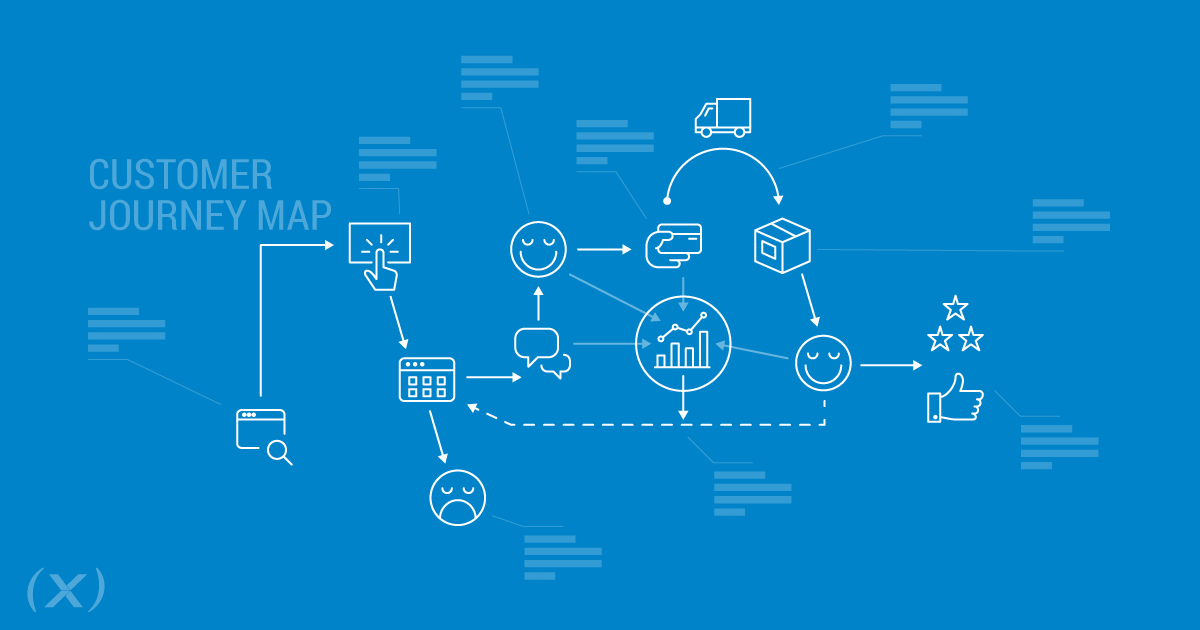
A close look at how deep insights into the customer journey take consumer experiences to the next level.
By Natalie Jackson and Julie Wright
Plenty love to tell the stories of famous business purchase pass-ups, like Yahoo’s Google refusal and Blockbuster’s no to Netflix, and for good reason: they’re a painful reminder of what happens when a business’s strategy falls out of touch with changing times. To be fair, Blockbuster wasn’t completely out of touch, even if it passed up a chance at a Netflix partnership. In 2004, then-CEO John Antioco started an initiative that may have helped the company rival Netflix’s growth by suspending Blockbuster’s hated late fees and investing in an online rental option, but the company’s board went pale at the sight of the changes’ $400 million price tag and pulled the plug. In 2005, having lost confidence in him, the board replaced Antioco with Jim Keyes, who reversed Antioco’s late fee suspension and online plans. Five years later, the company was bankrupt.
We’re looking at a very different economic landscape than even Blockbuster was—now more than ever, businesses need to learn from the company’s mistake and respond appropriately to global changes. With COVID-19 and its aftershocks continuing to rock the consumer world, purchasing habits have changed dramatically. Millennials, already a massive proportion of online shoppers pre-COVID, have outstripped every other demographic in almost every category of online purchasing growth. Businesses are witnessing an unprecedented loyalty shift, with 75% of consumers having tried a new shopping behavior since the pandemic began and stating that they plan to continue that behavior once the pandemic ends. Compared to last year, in a reversal of expectations, general merchandise sales in 2020 have increased by 10% over last year for the week ending September 19.
Businesses need to adapt their customer journeys to respond to these changes and either ride the wave of sales growth or blunt the impact of increased online competition. In such a tumultuous time, it’s also critical to analyze and explain these new consumer behaviors to internal audiences and teams so that your organization can mount an appropriate response. Businesses need to understand how customers are reaching their storefronts or service counters and what happens next—including how they feel at every touchpoint and stage of the interaction, from pre-contact to post-purchase. Change itself is important, but change informed by deep understanding of a customer’s journey through a business can prove revolutionary.
Introducing Customer Journey Mapping
From the customer’s point of view, the journey begins long before contact with a brand. It starts with a need. Following discovery of your brand or product as a solution to that need, it can continue for weeks, months or years through representatives at every level of your organization, and may end—if the experience has been exceptional—with your customers becoming advocates for your business. But effectively meeting the customer’s needs and preferences at every stage of their journey is challenging under the best of circumstances. To drive sales, loyalty, and brand advocacy in such an uncertain time as now, business leaders need to understand specifically how COVID has changed the customer journey so they can respond by providing the services, products, and safety measures that consumers demand.Providing such deep insights into the customer journey is exactly what (X) does with its Customer Journey Mapping. By stripping away fluff and documenting the unique needs and experiences of your patrons, patients or donors, Customer Journey Mapping equips your organization’s leaders to make confident operational decisions and craft marketing messages that will resonate with customers at every point of the journey. When an initiative is complete, Customer Journey Mapping provides insights into the drivers of your Net Promotor Scores, providing a clearer idea of which customers become promotors, why and at what key points in their journeys.
Starting the Journey
Most often, the customer journey starts not with contact but with a need or desire. For travelers, a bucket list; for trendy foodies, a search for the next culinary craze; for medical patients, a diagnosis. A unique kind of messaging and outreach is necessary for motivating every kind of customers to take the leap from need to contact.This stage of the journey is the top of your marketing funnel, and (X) uses these insights to advise on everything from key search terms to direct discovery to the tone of your first marketing message. For instance, a customer with a complex or emotionally-sensitive need may prefer that their first point of contact with your brand be purely educational and comforting, and may feel the need to build trust before they’re prepared to move through later stages in the funnel where messaging can become more transactional.
Companies with a clear understanding of their customers’ pre-contact feelings, questions, and concerns are better equipped than their competitors to craft messaging and develop the right marketing vehicles that will drive engagement and, ultimately, sales.
Creating an Experience
Visitors expect Anaheim’s Disneyland to be immaculately clean because the company has the clever strategy of making every “cast member” (employee) a custodian: whether the CEO or a brand-new ride operator, everyone picks up trash throughout the park. This is just one of the Magic Kingdom’s dozens of policies that help it maintain its brand image and world-famous customer experience. But not every company has such a clear brand personality. Customers might be unsure of what to expect from new changes and ventures, especially from businesses that pivoted or restructured during the pandemic.
Wineries and tasting rooms are a good example. The customer journey has changed dramatically since California’s reopening. Visitors to most winery tasting rooms are now required to have advance reservations and order food with their tastings. They must remain socially distanced, wear masks if they move from their table, and are expected to be traveling with members of their immediate family. This means that wineries and tasting rooms need to pro-actively communicate to their wine club members, website visitors and in-person bookings to set expectations about the experience while also keeping interest and excitement about the experience high. Once patrons are onsite, their experience must continue with all staff consistently delivering on expectations to ensure that guests feel safe, served and just as educated and entertained as they would have without all the precautions around coronavirus. (X) uses the Customer Journey Map exercise to illuminate where in the process guests are being let down and feeling disappointed, frustrated or turned off by the experience so that the business can evaluate its success in improving the experience and make adjustments if needed in order to retain customers.
An early understanding of customers’ initial expectations, as well as how changes might prove confusing, is crucial if a business wants to pursue pivots with poise and reap the customer loyalty benefits. Customer Journey Mapping provides that understanding, as well as a clear-cut communication and strategy outline to put it to use.
Reducing Friction Points
Airbnb took a step in the right direction during its initial pandemic response by offering digital experiences and expanding its refund policy, but faced fury when customers found that the expanded policy was inconsistent and sometimes plain wrong, denying refunds even to medical workers treating COVID patients.Airlines and other hospitality businesses adjusted their cancellation or rebooking penalties more fairly than Airbnb did, but beyond the effects of COVID, there are other, less visible causes of friction in many customer journeys. For instance, your business may be communicating unintended messages to minority customers through its marketing images depicting a customer mix that doesn’t reflect diversity. Or, you may have sales personnel who are too enthusiastic in their efforts to close business at a time when people are making slower decisions. These friction points and more could be turning off even loyal, repeat customers who now feel pressured or unseen. The Customer Journey Map will reveal tensions and friction in the journey that, if not corrected, can become offramps where customers abandon your brand and start seeking alternatives.
Another possible friction point, specific to COVID, has been consumers’ rush to online alternatives as substitutes for their favorite IRL brands. From restaurants to retail, customers are buying digitally, leaving neighborhood brick-and-mortar chains and boutiques that hadn’t already developed online ordering, take out or home delivery models sprinting to figure out how to pivot and do it well.
It certainly wasn’t planning for COVID at the time, but The Home Depot was one business that leaned into changing consumer behaviors and expectations in recent years, leading to a 24 percent increase in its year over year sales for Q2 2020 and putting itself in a unique position to grow even during the pandemic. The company launched a $1.2 billion investment in same- and next-day delivery starting in 2017, which has paid off as consumers are stuck at home and launching improvement projects of their own.
Target, similarly, was quick to launch no-contact pick-up services and provide the option of next-day delivery through the delivery app Shipt, which the retail giant acquired in 2017, but the company took its venture even further. Whereas challenges with cold storage prevented Target from offering grocery pickup in the past, the company seized the opportunity of the pandemic’s online-purchasing flurry and made 750 of its most popular grocery items available for curbside pick-up. As the pandemic has gone on, Target has continued to expand the service, and it’s hard to argue with the company’s curbside pickup growth, which now tops 700 percent.
By helping leaders clarify messaging about changes and identify possible operational sticking points in the transition process, Customer Journey Mapping allows businesses to head off damaging messaging, poor customer experiences, and gaffes like Airbnb’s long before they become organization-wide crises. On the flip side, Customer Journey Mapping equips businesses to make the confident, forward-thinking investments that let Home Depot and Target succeed even now. When a pivot’s success is more important than ever, clearly communicating that change to customers is equally vital.
Leveraging Every Touchpoint
As Domino’s recent rebranding campaign reminds us, employees at every level, including those operating ovens and registers, play just as large a role in selling a company’s image as managers and executives. By providing insights about customers’ needs and concerns, Customer Journey Mapping equips decision makers to train employees to empathize with customers, ensuring that all representatives are brand ambassadors and that a customer’s experience with a business will be of high quality and consistency at every level.
Using Customer Journey Mapping, (X) works closely with cross-functional teams who interact with their customers at various stages of the journey, from Marketing and Sales to Business Intelligence and Data Analytics, Operations and Supply Chain, and Customer Care and Tech Support teams, to name just a few. By bringing together key stakeholders with different day-to-day interactions with their customers, data, operations, and so on, Customer Journey Mapping creates an overall picture that reveals touchpoint gaps and opportunities to prioritize and address.
At (X), we study what customers are feeling at each stage of the journey, what questions they might ask, and how you as the client might fit into that. We put ourselves in the customer’s shoes throughout the journey, learn how to truly empathize, and enrich your employees’ service capabilities by passing the knowledge we gain on to them.
Shift Now or Forever Hold Your Peace
Some consumers are buying more, others are trying new brands, and still others are purchasing more online than ever before. What all three groups have in common is a dramatic change to their purchasing habits, and chances are, those new habits will stick around long after the pandemic is over. With three of four customers having tried a new brand since COVID began, do you have the clear image of your customers’ journey that you need to make the most of the unprecedented loyalty shift?
If not, (X) is at your service.
Julie Wright is a Partner in (X) and President of (W)right On Communications. Natalie Jackson is a Director with Excelerate.


